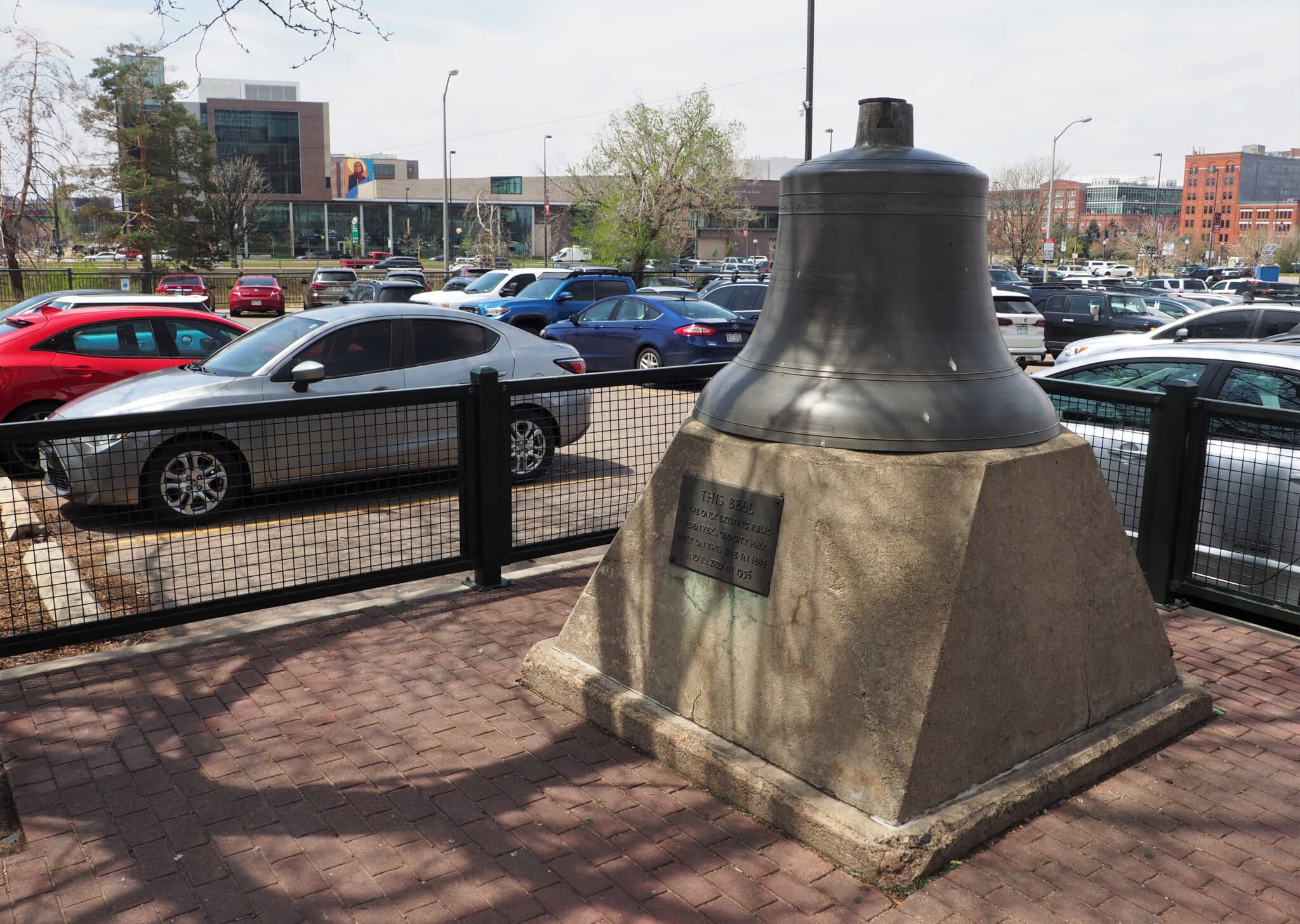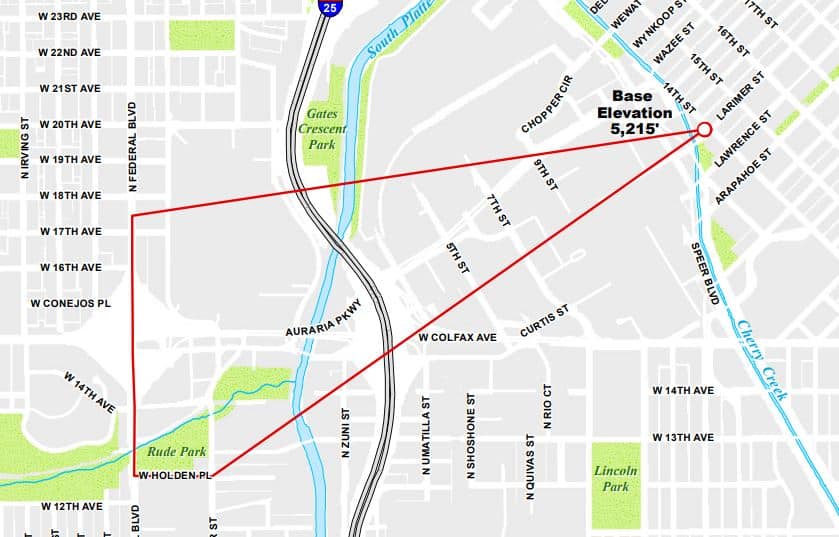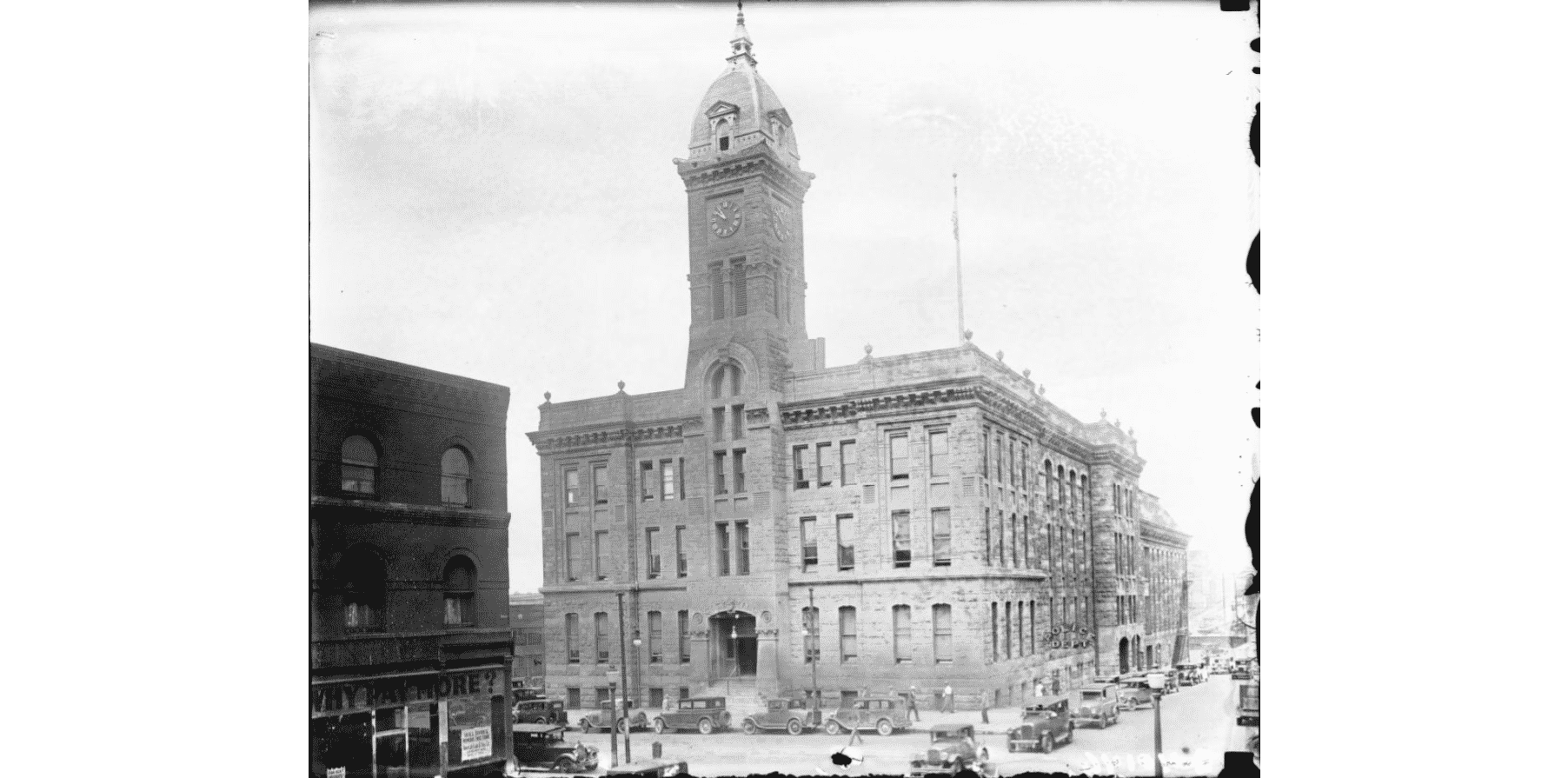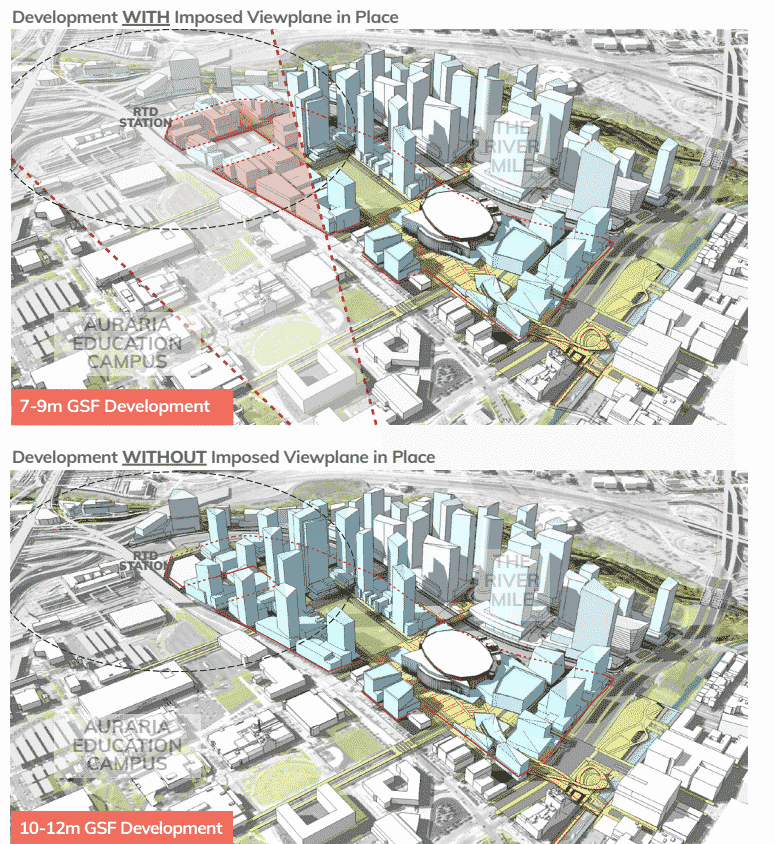
A bell marks the spot where Denver City Hall once stood, and the origin point for one of the city’s 14 view planes. (Thomas Gounley photo)
On the northwest corner of Larimer and 14th streets in downtown Denver, across the street from Larimer Square, there’s an old bell on a pedestal.
It marks the spot where Denver’s City Hall once stood. The four-story structure with a clock tower atop it, where the bell once rang, was constructed in 1883 and demolished in 1936.
The spot is also one of 14 in the city that is the origin of a view plane, areas in which building heights are capped in order to preserve a view — in this case, looking westward.
Stan Kroenke would like to be exempt from the Old City Hall view plane. Others already are.
The billionaire owner of the Colorado Avalanche and Denver Nuggets recently proposed redeveloping a 55-acre site anchored by Ball Arena, currently home to vast parking lots. The 41-page large development review document submitted by Kroenke Sports & Entertainment to the city in late March envisions millions of building square feet constructed on the site, along with park space.
The plans also note that 15 of those 55 acres are affected by the Old City Hall view plane, describing it as a “site influence.”
The view plane “will impact the massing and orientation of many properties on the development but KSE acknowledges the importance of these views in the neighboring developments,” the document states.

A map showing the boundaries of the Old City Hall view plane, which starts at the corner of 14th and Larimer streets. (Denver city documents)
At the same time, the plans also raise the prospect of altering the view plane so that it does not impact Kroenke’s 15 acres. “View plane vacation” is listed as a near-term priority for the project, along with public outreach and a rezoning of the site.
Why would Kroenke want that? His company says the view plane decreases the development potential of the Ball Arena site by four million to five million square feet, and significantly impacts the growth potential around the existing RTD Mile High Station, one of two transit stations that serve the site.
Laura Swartz, a spokeswoman for Denver’s Community Planning and Development Department, declined to directly comment on Kroenke’s proposal, noting that city staff are still reviewing it.
But Swartz said that there are two ways to get around a view plane. First, for significant changes, the view plane ordinance can be amended — a process that requires the approval of the Denver City Council and a signature from the mayor. Second, for one-off exceptions, property owners can request a variance from the view plane for their specific property from Denver’s Planning Board.
Swartz told BusinessDen that, since 1982, when Denver municipal code was recodified, four view plane amendments have been approved.
One of those, in 1999, exempted the Broncos stadium, as well as telecommunications facilities, from the Old City Hall view plane.
There’s another thing that already diminishes the Old City Hall view plane. It crosses over the Auraria campus. But the universities on that campus aren’t subject to it at all.
“Auraria Campus is a state entity, so they’re not required to follow local ordinances,” Senior City Planner Sarah Cawrse told 9News last year. “Because of that, the campus buildings can be built to go above the building height limitations. There are various campus buildings that essentially completely block the intended view from the origin point.”
As a result, the bell doesn’t have a view of the mountains in any meaningful way.
Matt Mahoney, senior vice president of project management and development for Kroenke Sports, said in a statement to BusinessDen that when the company originally started considering the project, it was “agnostic” about the view plane.
“The project is viable with the view plane in place,” he said.
But Mahoney noted the Auraria exemption, and that Denver also has public policies calling for increased density in transit and a greater amount of affordable housing.
“It seems that this particular view plane corridor potentially presents conflicting public policy objectives,” he said.
Mahoney also noted that a Downtown Area Plan Amendment approved by the council in 2018 suggested that the city consider removing the view plane entirely if new design standards and guidelines “effectively enhance key views and render the view plane obsolete.”
“We will continue to have dialogue with all the important stakeholders, including the city, community organizations and neighbors regarding our project and we believe the relative merits of the view plane will be one important topic of discussion as we go forward,” Mahoney said in the statement.

A photo of the old Denver City Hall at the corner of 14th and Larimer streets. The building was razed in 1936. (Denver Public Library Special Collections)
Other Denver view planes protect the view from the State Capitol, Coors Field, the Natural History Museum in City Park and specific spots in a number of parks, including Cheesman Park, Wash Park and Ruby Hill Park. Most of them seek to preserve the view west to the mountains, although three— at Sloan’s Lake Park, Hirshorn Park in LoHi and 51st & Zuni Park in Chaffee Park— preserve the view looking east at downtown.
The effects of a view plane on potential building height depends on how close the property is to the origin point.
Swartz noted that the view planes protect views from public property, although 9News highlighted that the origin point for the Coors Field view plane is in section 323. Coors Field is owned by a quasi-governmental stadium district, but a seat in that section for the Rockies’ weekend homestand against the Kansas City Royals later this month will set you back $25.
Besides the 1999 amendment for Mile High, here are the three other times Denver view planes have been amended, according to Swartz:
1984: The Southmoor Park view plane was amended to clarify the allowable 42-foot building height for structures in business zones after a dispute as to the interpretation of the original language.
2004: The Wash Park view plane was repealed and reenacted to expand the boundaries to the south and west and to allow a taller maximum elevation for buildings located west of an arc 9,000 feet from the point of origin.
2007: The Ruby Hill view plane was amended to exempt certain existing utility transmission lines (Xcel has high-voltage power lines in the area).
Additionally, since 2008, view plane variances have been issued twice. A City Park view plane variance was issued for rooftop equipment for St. Joseph Hospital when it was rebuilt at 1375 E. 19th Ave. And a Ruby Hill view plane variance was issued for a Colorado Public Radio broadcast tower and associated buildings and structures at 1601 W. Jewell Ave.
Correction: The number of downtown-facing view planes has been corrected.

A bell marks the spot where Denver City Hall once stood, and the origin point for one of the city’s 14 view planes. (Thomas Gounley photo)
On the northwest corner of Larimer and 14th streets in downtown Denver, across the street from Larimer Square, there’s an old bell on a pedestal.
It marks the spot where Denver’s City Hall once stood. The four-story structure with a clock tower atop it, where the bell once rang, was constructed in 1883 and demolished in 1936.
The spot is also one of 14 in the city that is the origin of a view plane, areas in which building heights are capped in order to preserve a view — in this case, looking westward.
Stan Kroenke would like to be exempt from the Old City Hall view plane. Others already are.
The billionaire owner of the Colorado Avalanche and Denver Nuggets recently proposed redeveloping a 55-acre site anchored by Ball Arena, currently home to vast parking lots. The 41-page large development review document submitted by Kroenke Sports & Entertainment to the city in late March envisions millions of building square feet constructed on the site, along with park space.
The plans also note that 15 of those 55 acres are affected by the Old City Hall view plane, describing it as a “site influence.”
The view plane “will impact the massing and orientation of many properties on the development but KSE acknowledges the importance of these views in the neighboring developments,” the document states.

A map showing the boundaries of the Old City Hall view plane, which starts at the corner of 14th and Larimer streets. (Denver city documents)
At the same time, the plans also raise the prospect of altering the view plane so that it does not impact Kroenke’s 15 acres. “View plane vacation” is listed as a near-term priority for the project, along with public outreach and a rezoning of the site.
Why would Kroenke want that? His company says the view plane decreases the development potential of the Ball Arena site by four million to five million square feet, and significantly impacts the growth potential around the existing RTD Mile High Station, one of two transit stations that serve the site.
Laura Swartz, a spokeswoman for Denver’s Community Planning and Development Department, declined to directly comment on Kroenke’s proposal, noting that city staff are still reviewing it.
But Swartz said that there are two ways to get around a view plane. First, for significant changes, the view plane ordinance can be amended — a process that requires the approval of the Denver City Council and a signature from the mayor. Second, for one-off exceptions, property owners can request a variance from the view plane for their specific property from Denver’s Planning Board.
Swartz told BusinessDen that, since 1982, when Denver municipal code was recodified, four view plane amendments have been approved.
One of those, in 1999, exempted the Broncos stadium, as well as telecommunications facilities, from the Old City Hall view plane.
There’s another thing that already diminishes the Old City Hall view plane. It crosses over the Auraria campus. But the universities on that campus aren’t subject to it at all.
“Auraria Campus is a state entity, so they’re not required to follow local ordinances,” Senior City Planner Sarah Cawrse told 9News last year. “Because of that, the campus buildings can be built to go above the building height limitations. There are various campus buildings that essentially completely block the intended view from the origin point.”
As a result, the bell doesn’t have a view of the mountains in any meaningful way.
Matt Mahoney, senior vice president of project management and development for Kroenke Sports, said in a statement to BusinessDen that when the company originally started considering the project, it was “agnostic” about the view plane.
“The project is viable with the view plane in place,” he said.
But Mahoney noted the Auraria exemption, and that Denver also has public policies calling for increased density in transit and a greater amount of affordable housing.
“It seems that this particular view plane corridor potentially presents conflicting public policy objectives,” he said.
Mahoney also noted that a Downtown Area Plan Amendment approved by the council in 2018 suggested that the city consider removing the view plane entirely if new design standards and guidelines “effectively enhance key views and render the view plane obsolete.”
“We will continue to have dialogue with all the important stakeholders, including the city, community organizations and neighbors regarding our project and we believe the relative merits of the view plane will be one important topic of discussion as we go forward,” Mahoney said in the statement.

A photo of the old Denver City Hall at the corner of 14th and Larimer streets. The building was razed in 1936. (Denver Public Library Special Collections)
Other Denver view planes protect the view from the State Capitol, Coors Field, the Natural History Museum in City Park and specific spots in a number of parks, including Cheesman Park, Wash Park and Ruby Hill Park. Most of them seek to preserve the view west to the mountains, although three— at Sloan’s Lake Park, Hirshorn Park in LoHi and 51st & Zuni Park in Chaffee Park— preserve the view looking east at downtown.
The effects of a view plane on potential building height depends on how close the property is to the origin point.
Swartz noted that the view planes protect views from public property, although 9News highlighted that the origin point for the Coors Field view plane is in section 323. Coors Field is owned by a quasi-governmental stadium district, but a seat in that section for the Rockies’ weekend homestand against the Kansas City Royals later this month will set you back $25.
Besides the 1999 amendment for Mile High, here are the three other times Denver view planes have been amended, according to Swartz:
1984: The Southmoor Park view plane was amended to clarify the allowable 42-foot building height for structures in business zones after a dispute as to the interpretation of the original language.
2004: The Wash Park view plane was repealed and reenacted to expand the boundaries to the south and west and to allow a taller maximum elevation for buildings located west of an arc 9,000 feet from the point of origin.
2007: The Ruby Hill view plane was amended to exempt certain existing utility transmission lines (Xcel has high-voltage power lines in the area).
Additionally, since 2008, view plane variances have been issued twice. A City Park view plane variance was issued for rooftop equipment for St. Joseph Hospital when it was rebuilt at 1375 E. 19th Ave. And a Ruby Hill view plane variance was issued for a Colorado Public Radio broadcast tower and associated buildings and structures at 1601 W. Jewell Ave.
Correction: The number of downtown-facing view planes has been corrected.

